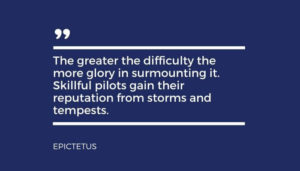Leadership in difficult times is as challenging as it is important. Essential, in fact.
Many of my clients seem to agree. As the excellent leaders of either today or tomorrow, they’re focused not only on helping their teams navigate our current climate of uncertainty, but also on upholding morale, maintaining culture, encouraging productivity, and so on.
But it’s a balancing act. Especially in a situation where we can’t easily conduct business as usual, predict timelines, or make the types of plans we’re accustomed to rolling out.
Which is why I’m spending a lot of time these days coaching people on adversity. How to approach it ourselves, and how to lead others through it.
![]() While some focus on overcoming adversity, I believe that posture misses a key point: namely, that adversity often brings with it incredible opportunity.
While some focus on overcoming adversity, I believe that posture misses a key point: namely, that adversity often brings with it incredible opportunity.
Today, I’ll summarize 7 of these opportunities in a recording, so you can tune in as you’re walking the dog (again). Just click here to skip ahead to the recording now.
I’ll also share some stories of people from history who have translated huge challenges into incredible opportunities. These real-life examples of adversity are wonderful for any leader to keep in his or her arsenal, as they’re a huge encouragement to others.
And if you (like me) collect stories of adversity for just this purpose, don’t hesitate to reach out and request more of them. I have a whole collection, and I like to share.
Since this has been a popular topic, I’m adding a freebie that I hope will support leaders and others: a quick-reference reminder guide that outlines the 7 key forces in a convenient, 1-page format. Feel free to share the PDF with your team, colleagues, friends, anyone!
And now, grab the dog and have a listen (or a read of the transcript below):
Listen Now: Leadership in Difficult Times
Transcript
I’m going to talk to you about a leadership tool that is very powerful in all times, but especially, I think, helpful in rapidly changing times like these—when we face all kinds of new experience that we really have no textbook for.
![]() A lot of people are calling this a crisis. Well, as we’ll discuss, a very powerful tool is the concept of opportunities coming from adversity.
A lot of people are calling this a crisis. Well, as we’ll discuss, a very powerful tool is the concept of opportunities coming from adversity.
Those who are newer to the game of life tend to respond to a problem by immediately seeking a remedy. We want to fix it. Hence, our focus on overcoming adversity rather than on looking to the opportunity that it carries with it.
People need hope. Not phony, “nothing’s wrong,” but believable positives.
So let’s look at those opportunities now. Let’s explore the positive things that come from changing times and challenging times.
What We’ll Cover
To do this, I’m going to
- First, share an illustration that’s often very helpful in revealing the upside of adversity
- Then, I’ll go over the 7 forces – 7 surprising kick-starters for success that get ignited in especially powerful ways during difficult times
- And finally, I’ll share a few stories about real people from history who famously approached difficulties without defeat, and discovered that it was within that very adversity that their great opportunity awaited. These stories are a wonderful help to leadership in difficult times—a great way to encourage and inspire people (including yourself!).
But before we get into all that, here’s a cool aside that you or your team might enjoy:
A Mandarin Lesson
The Chinese Mandarin language is ancient—thousands of years old. And it’s built on characters.
Interesting that in Mandarin, the word “crisis” is a combination of 2 little drawing’s—characters—that stand for “danger” and “opportune moment” or, in short, opportunity.
So yes, there is a threat: the adversity. But there’s also opportunity inside that adversity.
A Seafaring Metaphor
First of all, I’d like to take you through the story of a sailboat outing. It’s an invented story. The rest of the examples I give you will be true, but starting with this story sometimes helps put the idea of crisis and opportunity into context.
 If you picture yourself going out with a bunch of friends on your sailboat on a beautiful, gorgeous day. About 5 mile-an-hour winds, the sun is out, everything is perfect. You take a cooler, you have a great day. It’s gentle breeze…great for sailing.
If you picture yourself going out with a bunch of friends on your sailboat on a beautiful, gorgeous day. About 5 mile-an-hour winds, the sun is out, everything is perfect. You take a cooler, you have a great day. It’s gentle breeze…great for sailing.
You come home and everybody had a wonderful time. So they of course accept your invitation to repeat the next day.
The next day, you all get on board. But this time, while you’re out on the water, winds kick up to 50 miles an hour. The boat starts to take on water, the cooler goes overboard, and a couple of your guests almost go overboard as well. The mast snaps. The sails rip. You basically worry about getting back alive. And you barely make it to the dock.
Now, I submit to you, when I ask you which day you enjoyed the most, without question, it would be day number 1.
But when I ask which day you learned the most about your skill as a sailor, the ability of your crew, or the condition of your boat, you would tell me day 2. Day two wasn’t any fun, but it carried with it an awful lot of growth.
7 Positive Forces Released in Difficult Times
I have sorted out 7 categories where I’ve consistently witnessed when adversity looms its head, how the opportunity can pop up.
Opportunity #1 for Great Leadership in Difficult Times
The first 1: Adversity rewards natural strengths.
Because your instincts take over in crisis, and your instincts come out of you naturally.
Opportunity #2 for Great Leadership in Difficult Times
Number 2:
Adversity exposes weaknesses.
Easy times, good times, it’s easy to have defects in your operation or your processes that you get by with.
But in periods of crisis, you identify these defects. And you do something about it. So you come out a stronger organization.
Opportunity #3 for Great Leadership in Difficult Times
Number 3: It gives you some time to reassess your vision, and, what are your real, core, power-ally attributes?
Opportunity #4 for Great Leadership in Difficult Times
4th: You’ll change a bad habit much faster than you ever would without the pressure of a problem—without the necessity.
Opportunity #5 for Great Leadership in Difficult Times
And number 5: A sense of urgency can get you moving.
That overcomes inertia, and overcoming inertia has to happen before you can get momentum underway.
Opportunity #6 for Great Leadership in Difficult Times
Number 6: You’ll take more risk, quite simply because there’s less to lose.
Opportunity #7 for Great Leadership in Difficult Times
And lastly, number 7: Tough times can give you the shakeup you need to actually change the paradigm for the better—change your mental model and look at things in a brand-new way.
True Stories of Leadership and Hope in Difficult Times
Okay, now that you’re armed with those 7 forces that get unleashed in adversity, let’s get into a few real-life, historical examples.
These stories are great for leaders—and for everyone, in fact—to keep in your back pockets. Because they’re inspiring, reassuring, and motivating.
So much so that as a coach, I actually collect these stories of opportunity. So if you’d like to know more than the few I’ll share here, please get in touch.
Winston Churchill
One of the greatest stories of leadership in difficult times—leadership on a very large scale—is Winston Churchill during World War II and the bombing of London.
We think that we face issues today that are a crisis. Think about what it would feel like to have your city bombed every single night, 7 days a week. And Churchill, during that period of time, declaring, “We will never surrender.”
He made a point that every time he was seen—being driven in a car as prime minister, or walking through the streets, or entering a building, where anyone in the public could see him—he would hold up his hand in a victory symbol, with the now famous “V”.
And people were so lifted up. People chipped in. And they learned how to nurse and care for people. And they helped their neighbors.
This was a classic sign of leadership during the toughest kind of adversity.
Lee Iacocca
Another story that might resonate with you if you’re driving around in a minivan. (And if you’re not, all you have to do is look at all the minivans on the road.)
Guy named Lee Iacocca, who was president of Ford Motor Company for several years. And Henry Ford fired him. And Iacocca, in his autobiography, calls that the lowest point in his life.
Shortly thereafter, he became the CEO of Chrysler. And he took Chrysler through probably the toughest period in its entire existence. It was virtually a bankrupt company. In fact, Iacocca’s first function was to look for government help.
And the game-changing vehicle that he launched while CEO of Chrysler was the minivan. Which was a key part of saving the company.
Went from lowest point in his life to a famous CEO of a major turnaround company.
Vera wang
And finally, the story of a young lady who faced the adversity of failure:
She failed in the sport of her dreams—failed to make the Olympic team.
Then, she went to work for Vogue magazine and loved the publishing business and was desiring to be the editor for vogue and got passed over for the job. Imagine the discouragement that she probably felt.
And it wasn’t long after that, when she was planning her own wedding, that she discovered what a problem it was finding what she considered to be a decent wedding dress.
So Vera Wang invented her own—designed it and had it made. And from there on became, as many of you may know, one of the world’s most famous fashion designers.
Conclusion
I’ve been collecting adversity stories for 45 years, so there are many more where that came from.
But you can look up your own stories on the web. You can find people you think have been very successful and go look at their background, and you’ll find out all kinds of things that they faced earlier in their career—earlier in their life—that could have stopped them if they’d been defeated by difficult times, by crisis.
But they found the opportunity within that crisis.
So in conclusion: Don’t pretend there’s no crisis. That insults the people around you and the people that are counting on you for leadership.
And don’t just look for remedies and try to fix it—try to end the crisis.
Look for the opportunities these tough situations create. Look at the 7 potential benefits, and see what you can find during these times.
Feel free to use these with your team. They can be really effective in creating discussion along a positive set of lanes, where people start feeding on each other for the opportunity searches within the crisis.
Note: In the past, in writing about overcoming adversity and sharing examples of adversity, I’ve covered many of these topics around leadership in difficult times. Click on the above links to read those original posts as well.




Leave a Reply